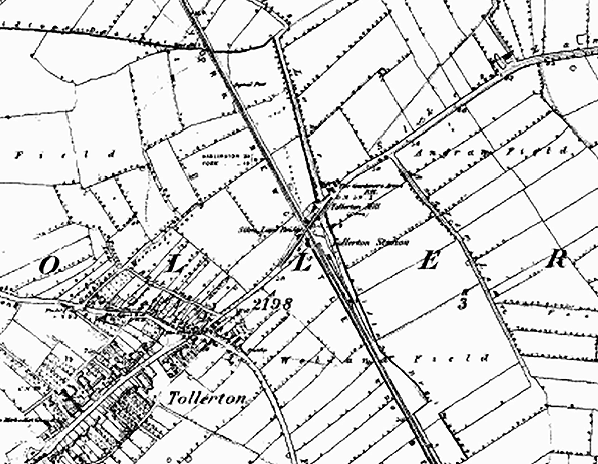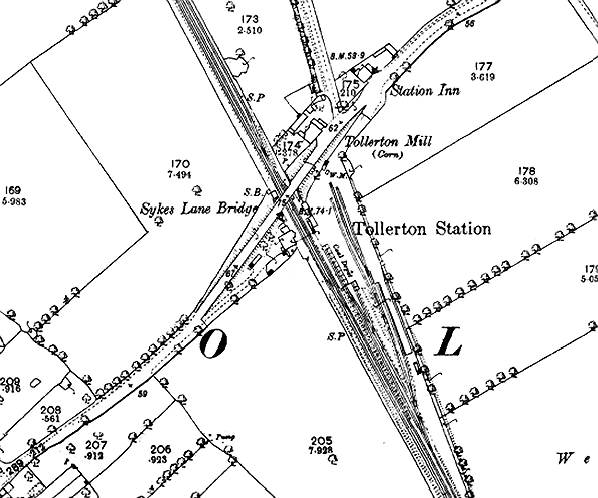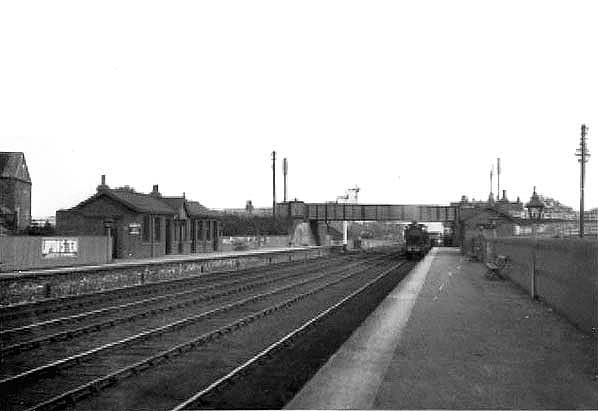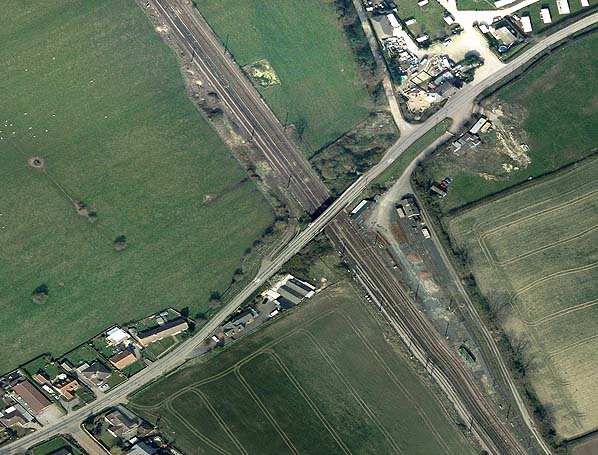
Station Name: TOLLERTON (1st & 2nd site)[Source: Alan Young]
old5.jpg) The down platform of Tollerton station, looking west, c1906. This is the new (2nd) station of 1899. The brick building is a single-storey structure, resembling many others built by the NER between 1890 and 1914, although most of them were of timber. The NER enamel running-in board displayed the station name on a terracotta-coloured ground. The Daily Telegraph is advertised on a sign below the nameboard. The station was oil lit throughout its life.
Copyright photo from John Alsop collection  
1856 1: 10 560 The first site of Tollerton station was directly south-east of the Sykes Lane crossing. The station building was on the down (northbound) platform, close to the road.

1893 1: 2 500 Tollerton station building can be seen on the down (northbound) platform, towards its north-west end, with an approach track. There appear to be two buildings on the up platform. Goods sidings are behind the up platform, one serving coal cells. At this time no goods shed is shown. The signal box is north of the road bridge on the down side of the line. Six years later, in connection with quadrupling of the route, Tollerton station was rebuilt immediately north-west of the road bridge.
 1909 1: 2 500 Tollerton station is shown north-west of the road bridge, having been constructed in 1899 to replace the earlier station which was south-east of the bridge. The reconstruction was required to allow space for the quadrupling of the former two-track route. A goods siding abuts the north-west end of the down platform, and the goods yard south-east of the bridge remains in use. The yard now has a shed parallel to the road without direct rail access. A new signal box has been built south-east of the bridge; it adjoins the former station building.
old6.jpg)
An undated (but before June 1911) view looking south-east from the down platform of Tollerton station. The down slow line serves this platform. To its left are the down fast, then the up fast and finally the up slow line serving the other platform. The modest scale of the buildings provided for this (2nd) Tollerton station, built in 1899, can be appreciated. Beyond Sykes Lane bridge the building of Tollerton (1st) station can be seen on the down side of the line.
Copyright photo from John Alsop collection old3.jpg)
Tollerton (2nd) station in the early twentieth century, looking south-east from the up platform. The small brick buildings, to the left and right, provided all of the platform facilities. Beyond the bridge the building of Tollerton (1st) station, which the 2nd station replaced in 1899, can be seen on the right. Beyond it is the station’s signal box, which replaced an earlier one on the near side of the bridge in 1899.
Photo from John Mann collection 
An undated view looking south-east from the down platform of Tollerton (2nd) station. The down slow line serves this platform. To its left are the down fast, then the up fast and finally the up slow line serving the other platform. The modest scale of the 1899 buildings can be appreciated, both of similar single-storey design. The bench supports are of the ‘knotted wood’ design, rather than the coiled serpent style which was possibly more common on NER stations. As with most rural stations Tollerton is oil-lit. Beyond Sykes Lane bridge the signal box and the building of the first station can be seen on the down side of the line. The goods yard is seen beyond and to the left of the bridge.
old7.jpg)
The up platform is seen from a down (northbound) express in 1961. The last advertised passenger service to use this platform was withdrawn by May 1959 and vegetation has begun to colonise it. The hand-painted wooden running-in board suggests that the station is open - although nameboards at several stations on the neighbouring Harrogate-York route were left in place some years after they closed. By this time Tollerton had only one advertised train call on weekdays, northbound at 7.04 am.
Photo by Phil Reeks  60007 A4 Pacific ‘Sir Nigel Gresley’ is speeding through Tollerton on the down fast track, hauling the ‘Talisman’ from London (Kings Cross) to Edinburgh (Waverley). The locomotive was one of the LNER’s 35-strong A4 class. Originally numbered 4498 she was released to traffic on 30 October 1937; after WW2 she was renumbered 7; under BR she was 60007. ‘Sir Nigel Gresley’ was allocated to Kings Cross ‘Top Shed’ from new, reallocated to Grantham on 23 April 1944, and returned to Top Shed on 4 June 1950. On 16 June 1963 she was reallocated to Peterborough New England shed when Top Shed closed. A further move took the loco to Edinburgh St Margarets shed, to work Edinburgh - Aberdeen trains. Her final BR shed allocation was Aberdeen from 20 July 1964. The loco was withdrawn from service on 1 February 1966, and the A4 Preservation Society (later known as the A4 Locomotive Society) rescued her from the cutter’s torch. ‘Sir Nigel Gresley’ was kept for many years at Steamtown Carnforth. By 1994 she was on the Great Central Railway, before spending some time at the East Lancashire Railway. The loco is now preserved on the North Yorkshire Moors Railway.
old4.jpg)
After the demolition of the second station at Tollerton, following its closure in 1965, a short section of the up platform with ramps at both ends was in situ in August 1969. It was possibly provided for railway staff who were working in the adjacent engineers’ sidings in the former goods yard.
Photo by John Mann
old2.jpg)
Tollerton station looking north-west along the down platform in 1964. The buildings date from the construction of the second station in 1899 north of Sykes Lane bridge, replacing the station south of the bridge. By this time only one passenger train called at Tollerton: the 7.16am for Edinburgh on weekdays which used this platform. The call was probably for handling parcels, perhaps explaining the presence of the sack trolley. The station closed in 1965.
Copyright photo from Station UK
1.jpg)
The former goods yard north of the road bridge at Tollerton, looking south in 2010; the yard is now used as an engineers' siding. The position of the first passenger station at Tollerton was on the extreme right of the photograph' a CrossCountry service is approaching.
Photo by John Furnevel 4.jpg) GBRf 'Shed' 66 723 'Chinook' passes the site of the first Tollerton station in March 2012, with the 4N30 Drax Power Station-Tyne Dock biomass coal train. Photo by Andrew Gallon from his Flickr photostream 5.jpg) An East Coast Inter-City 125 HST set, with power car 43367 'Deltic 50: 1955-2005' leading, hurtles south past the site of the second Tollerton station in March 2012.
Photo by Andrew Gallon from his Flickr photostream  Aerial view showing the site of the first and second Tollerton stations. The first station was to the south of the road bridge and the second station was to the north. The former goods yard on the up side south of the bridge is now an engineers' siding. Click here to see larger version. Click on thumbnail to enlarge
|







thumb6.jpg)
thumb3.jpg)
thumb2.jpg)

 Home Page
Home Page